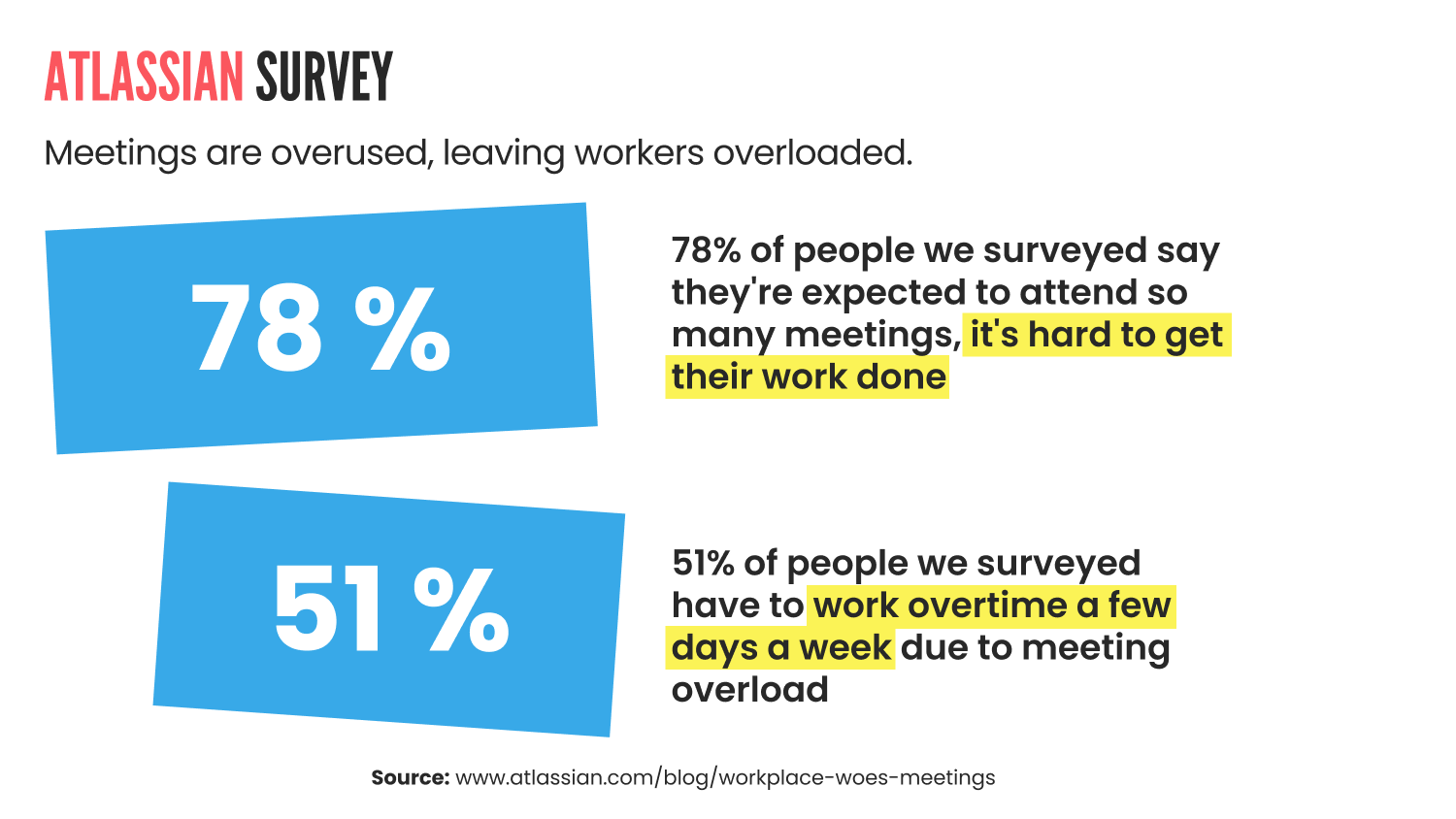02 May Survey: Meetings Are Top Productivity Barrier – Discover Actionable Solutions Inside
Atlassian research suggests reducing meeting time could enhance productivity by 80%.
We’ve all attended countless meetings and thought, “This could have been an email.”
Atlassian surveyed 5,000 knowledge workers across four continents and discovered the main hindrance to productivity: meetings.
They found meetings to be ineffective 72% of the time.
Meetings aren’t inherently evil; they’re often just poorly executed.
Research shows that the common meeting culture in many organizations prevents teams from reaching their goals by:
⚠️ Dominated Discussions: A few voices take over, hindering valuable contributions.
⚠️ Lack of Direction: Attendees leave unclear about decisions and next steps.
⚠️ Repetitive Information: Time is wasted on announcements easily communicated via email.
⚠️ Wasted Time: Meetings force people to listen to information that could be read in an email, impacting productivity.
⚠️ Focus Issues: Without a clear purpose and agenda, meetings become disorganized and unproductive.
This is a topic we care deeply about.
We often hear from individuals who are fed up with the corporate world, feeling trapped and exhausted from constant meetings. They see no other option but to leave.
Why are workplaces causing burnout?
How can we escape the meeting culture that pushes people away?
How can organizations improve?
Before discussing improvements, let’s first examine this survey in more detail.
Excessive Meetings Lead to an Overload on Workers
Meetings Often Fail to Achieve the Desired Outcomes
Do Not Cancel All Your Meetings, Just Improve Them
From Boring Meetings to Exciting Workshops
Conclusion: Escape the Meeting Maze and Unleash Productivity
Excessive Meetings Lead to an Overload on Knowledge Workers

Meetings are a cornerstone of collaboration, but what if they’re being overused?
Teams require a variety of collaboration techniques, customized to diverse needs – comparable to a Swiss army knife.
However, the survey indicates that many teams rely on a single tool: meetings.
The issue with this approach is that when you’re equipped with only a hammer, everything appears to be a nail.
Here’s a quick rundown of the key takeaways:
❌ Meeting Overload: 78% of respondents struggle to complete their work due to excessive meetings.
❌ Extra Hours: 51% of workers (and a staggering 67% of directors) report working overtime due to meeting overload.
❌ Employee Drain: 76% of respondents feel drained after days packed with meetings.
❌ Less Time, More Productivity: 80% believe they’d be more productive with less meeting time.
❌ Schedule Dictation: For 54% of knowledge workers, meetings dictate their daily schedule, leaving little time for focused work.
The message is clear: we’re all overloaded, and it’s killing productivity.
Companies have to shift away from meetings as the default way information is shared. 80% of workers say they would be more productive if they spent less time in meetings. - Dr. Molly Sands, Head of Team Anywhere Lab at Atlassian
That’s what happens when meetings are our only collaboration tool.
However, the solution is simple. Treat meetings as one tool in your collaboration toolbox, not the only option.
But let’s first discuss productivity and desired outcomes. We’ll provide better options for you to consider later.
Meetings Often Fail to Achieve the Desired Outcomes
Despite meetings being the dominant method for group collaboration, they often fall short in delivering results.
For example, managers often schedule meetings to foster teamwork and build connections between colleagues.
Ironically, 55% of employees report feeling lonely at work, even on days packed with meetings. This disconnect highlights a broader issue: meetings often fail to achieve their intended goals.
Additionally, 54% of workers leave meetings confused about next steps and task ownership. This lack of clarity further undermines the effectiveness of meetings.
Essentially, the research across various purposes of meetings, such as decision-making, status updates, and goal alignment, reveals a consistent theme: meetings simply aren’t delivering.
The individuals surveyed stated that meetings are ineffective for…
Then you may ask, “What are meetings effective for?”
While meetings are a common part of professional life, their effectiveness is a subject of discussion.
Interestingly, the research has found that meetings are particularly effective for one specific outcome: generating even more meetings!
This might sound amusing, but it’s a reality many of us face within the corporate world.
A significant 77% of surveyed employees reported they frequently attend meetings that conclude with a decision to schedule a follow-up meeting.
This suggests that meetings serve as a platform for further discussion and decision-making, rather than being a venue for finalizing decisions.
So, if you find yourself often scheduling follow-up meetings, you’re definitely not alone!
The message is clear: we need a shift in how we approach collaboration.
The good news? There are alternatives to the never-ending meeting cycle!
Do Not Cancel All Your Meetings, Just Improve Them

Let’s face it, meetings are a fact of teamwork. However, they don’t have to be unproductive.
Research provides significant insights on how to enhance the effectiveness of necessary meetings:
🎯 Crystal Clear Goals: A whopping 62% of workers show up to meetings without a clue about the objective. Setting a clear goal in the invite takes mere seconds, yet primes everyone’s minds for a focused discussion.
📋 Agendas: Friend, Not Foe: Don’t underestimate the power of an agenda. 79% of respondents agree it leads to more productive meetings. While it takes some time upfront, the payoff is well worth it.
⏱️ Time Crunch Challenge: Who says meetings have to be 30 minutes long? A staggering 80% of workers believe most meetings can be halved. Test this by setting 15 minutes as your default. Longer meetings are okay, but make them a conscious choice.
✅ Participation Puzzle: Nearly half (43%) struggle to get a word in due to meeting dominators. A skilled facilitator can keep things balanced. Their process expertise keeps things on track, while their focus on facilitation lets internal team members fully participate. They can manage group dynamics and create a safe space for open discussion. This can save time and lead to a better overall experience.
Attention leaders! Adopting these better-meeting behaviors is especially important for you. As the usual organizers of meetings, you greatly influence culture.
However, it’s not necessary to implement all changes at once. Start with what feels manageable and gradually build from there.
What other measures can you take to prevent meeting overload?
Reclaim Your Schedule

While there’s no magic cure for meeting overload, there are methods to manage the chaos.
If you’re prepared to be the change you seek, here are the initial steps we recommend, based on our experience:
📅 Calendar audit
Identify meetings that you can eliminate, question, or avoid attending. For the necessary meetings, try to schedule them consecutively to create room for focused work. Remember to set aside time for exercise, drop-offs, and other essential personal tasks.
📹 Try async video
Say goodbye to status meetings! Consider using asynchronous video tools for broadcasting information through video messages. This method retains the ‘human touch’ and allows your audience to watch at their convenience. It’s a win-win situation!
📄 Redirect meetings with documents
Whether you’re creating a quarterly plan, project pitch, or technical design, begin by sharing your idea in your preferred team workspace to gather asynchronous feedback. Depending on the feedback, a live follow-up discussion may be necessary, or it may not be!
🔍 Reduce, reschedule, reflect
Consider trying Atlassian’s Ritual Reset play with your team. This workshop exercise helps you reassess your routine meetings, determining which ones are still valuable, which ones need adjustments, and which ones should be discontinued.
🎙️ Improve your meeting facilitation skills
Guiding discussions, managing different personalities, ensuring everyone’s voice is heard, and keeping meetings focused on their goals can enhance team collaboration and productivity. Our article offers actionable tips to improve the efficiency and satisfaction of meetings.
🛠️ Use the right tools
The right tools are vital for enhancing meeting effectiveness, impacting productivity and engagement beyond the meeting’s agenda or structure. Hence, we’ve compiled a list of 57 top facilitation tools for online workshops and meetings.
🧩 Run workshops instead of meetings
It’s no secret – we are strong advocates for using workshops instead of meetings, or rather, we use workshops for our most important meetings. In the following section, we will show you how.
From Boring Meetings to Exciting Workshops

🔴 Meetings
While meetings are intended for collaborative discussions and decision-making, they can often devolve into passive exercises in information sharing. This shift away from active participation can hinder the engagement and productivity necessary for effective collaboration.
Here are some considerations on the effectiveness of meetings:
❌ Passive information sharing: Meetings can sometimes turn into one-way communication, where attendees are only receiving information instead of actively participating.
❌ Lack of interactivity: Without effective engagement strategies, participants may lose interest in meetings, leading to disengagement and less successful outcomes.
❌ Broad topics, lack of focus: Meetings often cover a wide range of topics, which can result in a lack of direction and clarity, making it challenging to achieve specific objectives.
❌ No clear next steps: Meetings often lack concrete plans or specific actions for moving forward. Attendees may leave with increased understanding, but without clear ownership or next steps.
🟢 Workshops
Enter the concept of “Don’t Have a Meeting, Throw a Workshop!”
In contrast to traditional meetings, workshops offer a refreshing alternative that prioritizes interactivity and tangible outcomes.
Here’s why workshops stand out:
✅ Designed for participation: Workshops are carefully structured to maximize engagement, with each participant actively contributing. Through various techniques, these workshops cultivate a sense of shared purpose among attendees.
✅ Focused objectives: Workshops concentrate on specific issues or objectives, guiding participants towards creating actionable solutions. This targeted approach is a time saver.
✅ Expert facilitation: The success of workshops depends on facilitation. Skilled facilitators use methods like group icebreakers and imaginative brainstorming activities to maintain participant engagement, energy, and productivity.
✅ Actionable outcomes: By the end of a well-designed workshop, participants don’t just discuss problems; they co-create actionable solutions that they can implement to move forward. This focus on tangible outcomes sets workshops apart from traditional meetings.
If you’re interested in learning more about workshops, please read our articles: What is a Workshop and A Comprehensive Guide to Workshop Facilitation.
Conclusion: Escape the Meeting Maze and Unleash Productivity
Meetings are a cornerstone of collaboration, but drowning in them is a surefire way to sink productivity.
The good news? You don’t have to ditch meetings entirely.
By following these key takeaways, you can transform them from time-sucks into springs of innovation:
✅ Rethink Collaboration: Meetings are just one tool in your toolbox. Explore asynchronous communication, document sharing, and project management software.
✅ Prioritize ruthlessly: Challenge the need for every meeting. Can it be an email, a video message, or a document shared in your workspace?
✅ Embrace the Agenda: A clear agenda sets expectations and keeps discussions focused.
✅ Timebox your discussions: Timeboxing improves meeting productivity. Many meetings can be shortened. Establish a timer and adhere to it!
✅ Facilitate, Don’t Dictate: A skilled facilitator keeps everyone engaged and ensures all voices are heard.
✅ Workshops over Meetings: For crucial discussions, consider a workshop. Workshops are interactive, focused, and designed to produce actionable results.
Take back control of your schedule and watch your productivity soar!
This article provides a springboard, but the journey to meeting mastery is yours to embark on. We encourage you to explore further resources, experiment with different techniques, and find what works best for you and your team.
Remember, a little planning and a commitment to improvement can turn meetings from mundane to magnificent.
Learn more about the Atlassian survey here.
Get in Touch
Say goodbye to pointless meetings and embrace gatherings that foster collaboration and drive results. No more sessions that could have been just an email.
If you’re interested in transforming unstructured meetings with flawed dynamics into structured workshops and integrating them into your business, please contact us.
We’re ready to guide you through the process of effective workshopping.

